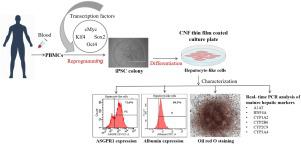Colloids and Surfaces B: Biointerfaces ( IF 5.8 ) Pub Date : 2020-11-12 , DOI: 10.1016/j.colsurfb.2020.111466 M R Poorna 1 , S Sudhindran 2 , M V Thampi 3 , Ullas Mony 1

|
Differentiation of hepatocyte-like cells (HLCs) from human induced pluripotent stem cells (iPSCs) in vitro has great potential in regenerative medicine. Current protocol uses matrigel of animal origin as a substrate for the differentiation of iPSCs to HLCs. Use of an appropriate non-xenogenic substrate is very important for potential future clinical applications. Towards this goal, we used Cellulose Nanofibril (CNF) gel, a natural, non-toxic, biocompatible and biodegradable polymer in humans as a thin film substrate for the differentiation of iPSCs to HLCs. Here we demonstrated that CNF as a substrate film can efficiently differentiate human iPSCs to HLCs. We investigated the expression profile of the endoderm markers (SOX17 and CXCR4), hepatoblast markers (EpCAM and AFP) and mature hepatocyte marker (ASGPR1) by flow cytometry during the differentiation of iPSCs to HLCs on both CNF and matrigel substrates. We also tested the HLCs generated from both the substrates for the expression of hepatic markers such as A1AT, HNF4A, CYP450 isotypes by Real Time-PCR and its mature hepatocyte functions (lipid accumulation and albumin expression). Our results showed that the differentiated HLCs from both the substrates are comparable and expressed stage specific hepatocyte markers as well as functional maturity. We have demonstrated that CNF, a natural biomaterial, may be used in tissue engineering applications as a potential substrate for the differentiation of iPSCs to HLCs.
中文翻译:

在纤维素纳米原纤维基质上诱导多能干细胞向肝样细胞的分化
从人肝细胞样细胞(HLCS)的分化诱导多能干细胞(iPS细胞)体外在再生医学上有很大的潜力。当前方案使用动物来源的基质胶作为将iPSC分化为HLC的底物。适当的非异种底物的使用对于潜在的未来临床应用非常重要。为了实现这一目标,我们将纤维素纳米纤维(CNF)凝胶(一种人类天然,无毒,生物相容性和可生物降解的聚合物)用作薄膜基质,用于将iPSC分化为HLC。在这里,我们证明了CNF作为底膜可以有效地将人iPSC区分为HLC。我们通过流式细胞术研究了内胚层标志物(SOX17和CXCR4),成肝细胞标志物(EpCAM和AFP)和成熟肝细胞标志物(ASGPR1)在iPSC向CNF和基质胶底物上的HLC分化过程中的表达情况。我们还通过实时PCR检测了两种底物产生的HLC的肝标记物(如A1AT,HNF4A,CYP450同种型)的表达及其成熟的肝细胞功能(脂质蓄积和白蛋白表达)。我们的结果表明,从两种底物分化出的HLC均具有可比性,并表达了阶段特异性肝细胞标记物以及功能成熟度。我们已经证明,CNF,一种天然生物材料,可以在组织工程应用中用作将iPSC分化为HLC的潜在底物。我们的结果表明,从两种底物分化出的HLC均具有可比性,并表达了阶段特异性肝细胞标记物以及功能成熟度。我们已经证明,CNF,一种天然生物材料,可以在组织工程应用中用作将iPSC分化为HLC的潜在底物。我们的结果表明,从两种底物分化出的HLC均具有可比性,并表达了阶段特异性肝细胞标记物以及功能成熟度。我们已经证明,CNF,一种天然生物材料,可以在组织工程应用中用作将iPSC分化为HLC的潜在底物。



























 京公网安备 11010802027423号
京公网安备 11010802027423号